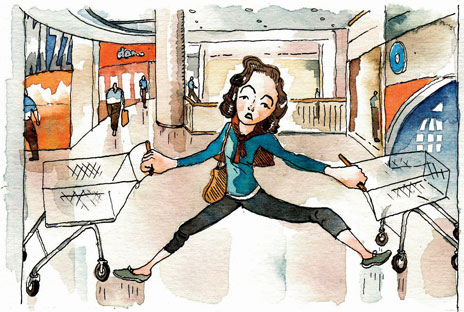6 Common Shopping Traps—And How to Avoid Them

Illustration: Barry Blitt
It's a hunt. It's therapy. It's a way of life. But has it gotten out of control? Aimee Lee Ball investigates why we spend the way we do.
Alas, our romance with shopping seems to be coming to an end—or at least it's up for careful reevaluation. According to research from Stanford University, more than one in 20 adults are compulsive shoppers, purchasing things they don't need, use, or even want. That's because shopping, once devoted to procuring necessities, has come to fill multiple emotional needs—it's entertainment, a bonding activity, a sport, a form of self-expression, and, quite often, a means of solace. "These days what you buy is a way to connect to others and showcase your personality and values," says Kit Yarrow, PhD, professor of psychology and marketing at Golden Gate University in San Francisco. So what happens now when more than five million people have lost their jobs since December 2007, and many of us are trying to curb our enthusiasm? Ironically, "when people feel economically insecure, they tend to reassure themselves by shopping," says George Loewenstein, PhD, professor of economics and psychology at Carnegie Mellon University in Pittsburgh. The thinking is: "If I were economically secure, I would go shopping, so if I'm shopping, I must be economically secure." And that's just one thing to be aware of as you head for the mall. Here are a few others: 1. You'd Better Shop Around
The image of an angel and a devil sitting on a person's shoulders is not a bad metaphor for shopping. Using brain scans, researchers have shown that the nucleus accumbens, an area associated with pleasure and reward, lights up as people consider a purchase, while the insula, a structure that plays an important role in pain, is activated when they think about the cost. The two brain areas compete with each other to determine whether you will buy something. Your typical tightwad, says Loewenstein (who conducted the brain research with Brian Knutson, PhD, of Stanford), feels the pain of paying for things more acutely. Spendthrifts may not register it enough.
Buying a lot in one store can decrease your sensitivity to the pain of cost, says Loewenstein. "You hit the what-the-heck effect: You've spent $200; what's another $20 for a T-shirt?" He recommends going to various stores for different purchases.
2. Don't Buy Into Bargains
Another factor that can tip the brain's pleasure-pain dynamic is a bargain. Knutson and Loewenstein have shown not only how the brain weighs making a purchase but also how it reacts to price. The researchers gave subjects $20 to spend on a series of products they saw on a computer screen. When the shoppers considered the prices excessive, the insula became activated; when they saw discounts, their accumbens lit up like a Broadway marquee. The prefrontal cortex, associated with weighing gains and losses, also became active along with the accumbens—and this pattern predicted a shopper's decision to buy.
Sales, markdowns, two-for-ones, and outlet stores are all designed to hit our bargain-loving Achilles' heel. So are retail tactics we should be wise to, like buying an item for $29.99 because we tend to discount it to $20 instead of $30, says Ellen Ruppel Shell, author of the new book Cheap: The High Cost of Discount Culture. "Even psychologists confess that they've been seduced." The anticipation of getting a good deal, says Shell, is what drives us toward the cash register, not the object itself—and as a result, we end up with stuff we don't particularly want.



